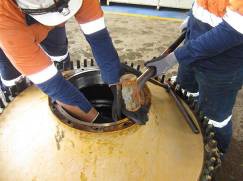
Mines safety bulletin no. 133 | 03 May 2013 | Version 1
Preventing serious hand injuries
Hand injuries are the second most commonly reported lost time injuries in the Queensland mining industry after back injuries. Approximately 16%, or 275, of all lost time injuries reported in the period 2007–12 were hand injuries. In that five-year period four injury types comprised nearly 80% of all serious hand injuries.
- fractures (30%)
- lacerations, cuts and other open wounds (25%)
- crush injuries (15%)
- traumatic amputations (9%)
Because hands are complex body parts, they do not always perform the same way, or as well, after they have been seriously injured, even after rehabilitation. Nearly 9% of all permanent incapacities reported in 2011–12 by Queensland mines were associated with hand-related injuries.
What are the causes of serious hand injuries?
There are many work activities that contribute to serious hand injuries in the Queensland mining industry. Maintenance activities contributed over half of the injuries reported during the 2007–12 period. The largest proportion (44%) of serious hand injuries occurred while working on equipment. A further 15% of injuries were caused by the operation of portable power tools and non-powered hand tools.
The most common mechanisms of injury included these causes:
- trapped between stationary and moving objects (29%)
- hit by moving objects (19%)
- hit by falling objects (10%)
- trapped by moving machinery (10%)
Preventing serious hand injuries
Hands are often the body part nearest to a hazard. Risk controls need to focus on lowering the exposure of hands to hazards that can cause serious hand injury.
Most information for preventing hand injuries recommends the selection and use of gloves as the primary risk control. However this is the least desirable control option.
Research and industry experience has shown that although gloves can significantly lower the risk of lacerations, cuts, burns and chemical exposures they do not lower the risk of fractures, crush injuries or amputations which make up over 50% of serious hand injuries experienced in Queensland mines. Two of the recent serious injuries mentioned above demonstrate the limitations of gloves.
More emphasis should be placed on controlling the risks of fractures, crush injuries and amputations during maintenance activities.
Table 1. Examples of controls to prevent serious hand injury
| Preventative control | Examples |
|---|---|
| Substitution | Use hydraulic press instead of hammer and drift |
| Isolation/separation | Guarding of hand pinch and nip points |
| Engineering |
|
| Administrative |
|
| Training |
|
| Personal protective equipment |
|
Recommendations
Site senior executives of coal and metalliferous mines should make sure that people with an obligation to manage this risk use the following methods.
- Target maintenance activities for serious hand injury prevention.
- Assess the risk of serious hand injury at the activity and/or task level, including the operation of powered and non-powered hand tools.
- Establish specific preventative controls that reduce the likelihood of serious hand injury.
- Work with designers, erectors, installers, manufacturers, importers and suppliers of plant to rectify hazards where the risk of serious hand injury from use or maintenance is at an unacceptable level.
Recent serious hand injuries
Four serious hand injuries requiring medical treatment or hospitalisation occurred over the 2013 Easter period:
28/03/2013: A boilermaker assisting to fit a lip shroud to an excavator bucket crushed a finger when it was caught between the shroud and the ramp bar as other fitters involved in the job were pushing the shroud into place.
30/03/2013: An operator removing a coal blockage in a ROM bin feeder had the tips of two fingers crushed and amputated when the coal he was attempting to remove slumped, causing his fingers to be caught between the jackhammer he was using and the inner wall of the feeder. The operator was wearing gloves.
31/03/2013: A fitter removing a boom lock pin on an excavator crushed a finger when it was struck by the pin after it slipped out of his right hand and fell onto his left hand.
02/04/2013: An apprentice fitter assisting with the removal of a bearing assembly on a wheel hub by holding a steel drift crushed and broke a finger when his hand was stuck by another fitter using a sledge hammer. The apprentice was wearing gloves. The photo below is a re-enactment of the incident.
Further reading
Further guidance about how to prevent hand injuries can be found in the South Australian Mining and Quarrying Occupational Health and Safety Committee Final project report, Hand safety in South Australian mines and quarries (October, 2011).
Contact: minesafetyandhealth@dnrm.qld.gov.au
Issued by Queensland Department of Natural Resources and Mines
Find more safety notices
Search the hazards database

